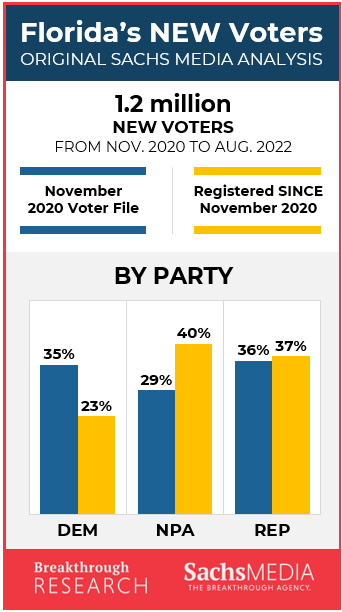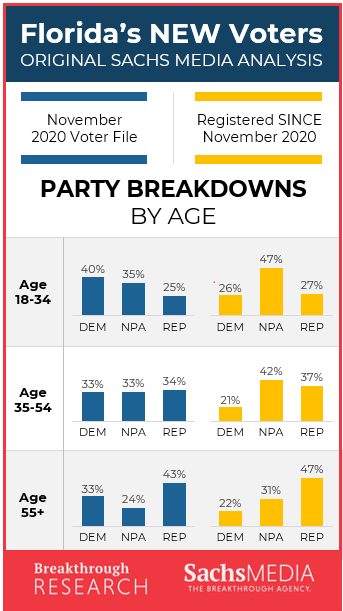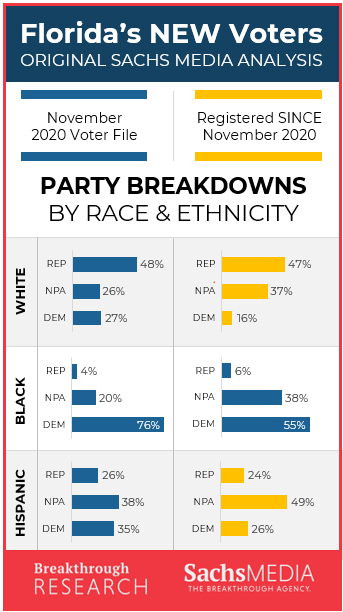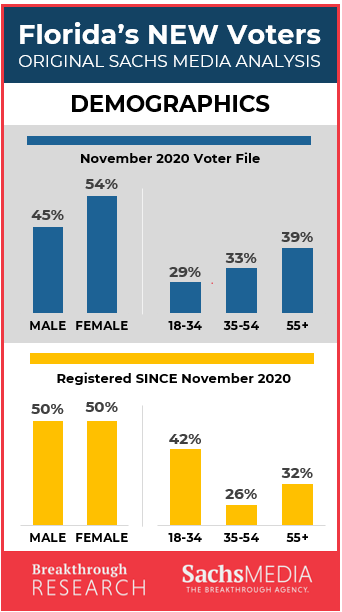#1. About 1 in 12 Florida voters weren't registered to vote in the state in 2020
Next week, Florida's 2022 General Election will close, with many of Florida's 14.5 million registered voters deciding who will hold various state and federal offices for the next two, four, or six years. Since the last time Floridians cast ballots in a statewide election in November 2020, nearly 1.2 million new voters have registered to take part in this civic act. That means that about one in 12 Florida voters today weren't on the rolls two years ago.
Who are these newly registered voters, and how do they compare with the universe of voters already on the rolls? Our research division at Sachs Media conducted an analysis to identify demographic differences between then and "new," with some stark findings — particularly relating to party affiliation.
Many have noted an overall growing registration advantage for Republicans in Florida. But beneath the surface, a lot more is going on.
#2. Party registration is shifting away from Democrats to nonpartisan affiliation
In November 2020, about as many voters were registered as Democrats (35%) as Republicans (36%), with the remaining 29% unaffiliated with either major party.
Among those who have registered since November 2020 ("new voters") the share identifying as Democrats declined 13 points to 23%, while the portion affiliating with NEITHER party jumped 11 points to 40%. Meanwhile, Republican registration is about equal, with 37% of new voters checking that box.
This means that Florida's growing Republican registration advantage is due largely to the share of voters consistently held by the GOP, combined with significant movement away from Democrats and toward nonpartisans.

#3. Democratic registration is down across the board, including among young voters, and those of every race and ethnicity
The portion of new voters who register as Democrats is down among every demographic group. Take voters younger than 35, for example: Two years ago, four in 10 were registered Democrats. And yet since then, barely more than one-quarter of new voters (26%) in this age group affiliate this way — a significant drop-off. On the other hand, nearly half of young new voters (47%) are unaffiliated with either party and 27% are Republicans.
This same pattern is seen among those ages 35-54 and ages 55 and older — Republican registration is up a few points over November 2020, but the real shift is from Democrats to nonpartisan affiliation.

Breakdowns by race and ethnicity are equally telling.
In 2020, "Democrat" was the chosen party affiliation of 27% of white voters, 76% of Black voters and 35% of Hispanic voters. Among new voters registered since 2020, the numbers show a clear shift, at 16%, 55%, and 26%, respectively. In other words, the portion of new Black voters who align as Democrats is about 25% lower than what was seen in Florida's 2020 voter file.
Meanwhile, Republican registration is steady across the board — within two percentage points for all groups.

#4. The gap between female and male registration is narrowing
In November 2020, women (54%) made up a significantly greater portion of the electorate than did men (45%). Yet among Floridians who have registered to vote since, half are men (50%) and half (50%) women. While female turnout rates may continue to exceed those of men, it's notable to see such a swift balancing in registration alone.
Not surprisingly, the age distribution of new voters is significantly younger than those who were already in Florida's voter rolls in November 2020. Specifically, 42% of new voters are younger than 35, compared with 29% in the existing voter rolls. This likely reflects a mass of first-time voters, who either aged into eligibility or became motivated to register for the first time.

#5. Proportionally more of Florida's newest voters are registered in smaller counties
Finally, the geographic location of Florida's new voters looks a bit different from the state as a whole, with proportionally more new voters living outside of the state's largest counties. For example, while 10.5% of Florida voters lived in Miami-Dade and 8.6% lived in Broward in November 2020, just 7.9% and 6.5% of new registrations were within these two large counties since then.
Meanwhile, new registrations in smaller counties such as Lee, Osceola, and Sumter accounted for a larger share of the state's new voters than they did of the overall voter rolls two years ago.
So, what does it all mean?
To be clear, the party breakdown in today's Florida voter roll still looks much like it did in November 2020 — but the differences seen between 2020 voters and those who have registered in the past two years show a dramatic shift away from the Democratic Party and toward nonpartisanship. If these trends continue, the voter composition 10 years from now could look very different indeed.
If the shift toward nonpartisan affiliation was evenly distributed, with comparable registration declines for both Democrats and Republicans, it would be much easier to suggest that the composition of new voters reflects a large-scale rejection of the traditional party structure. But that's not what we see here. Rather, a meaningful portion of voters who would have once been Democrats are now registering as unaffiliated, while the share of Republicans stayed consistent.
What remains to be seen is how all those new registrants will actually vote, regardless of the party name (or lack thereof) on their registration card. For that, stay tuned.
Our Sachs Media survey of Florida's new voters is in the works.
___
Karen Cyphers, Ph.D., is a partner at Sachs Media and faculty at Florida State University. She can be reached at karen@sachsmedia.com.






No comments:
Post a Comment